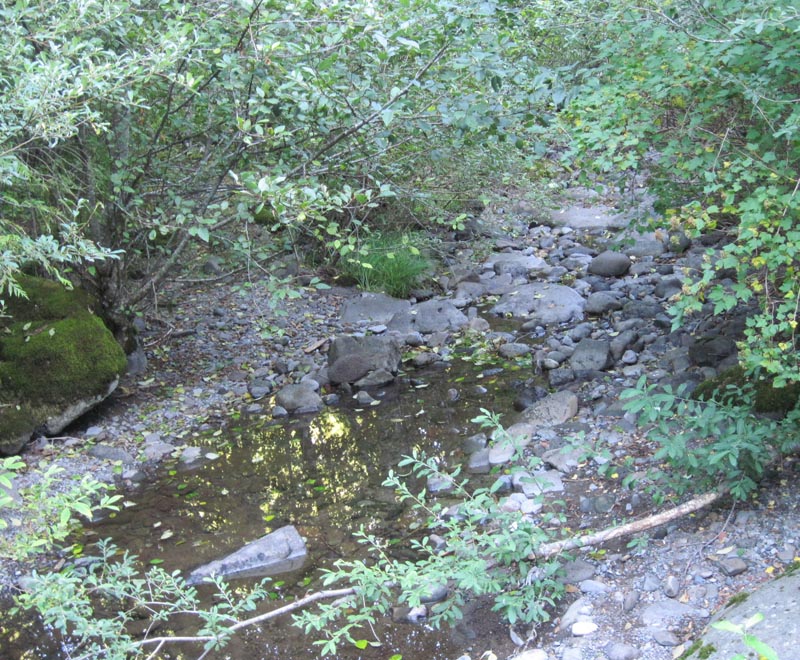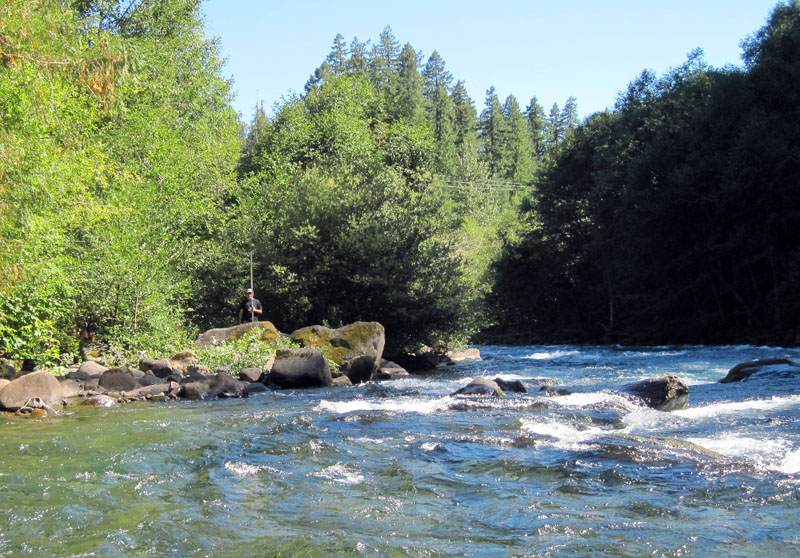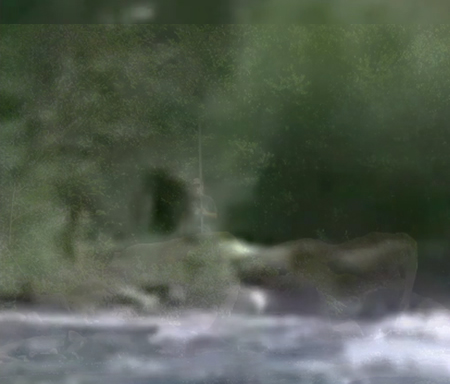Background
On Saturday June 28, 2008 three men set out to make a fly fishing video on the Upper McKenzie River in the Willamette National Forest in Oregon. The three men either work at or are associated with a fly fishing shop called The Caddis Fly Shop located in Eugene, OR. They launched two drift boats from Olallie Campground in the late morning and started their float downstream. George R. was alone in one boat, and Chris D. and videographer Matt S. were in another.
As they rounded a left turn in the river approaching the rapids named Fish Ladder, George’s drift boat was ahead of the other one. Trailing in the second boat, Chris and Matt positioned themselves to film George’s descent over the class IV rapids ahead of them. As the two boats’ oarsmen navigated the treacherous rapids, Matt did his best to keep the camera steadily on George.
Soon the boats had cleared the rapids and the group floated on to shoot other scenes for their video. The video was posted to Matt’s YouTube account on Monday, June 30, 2008. Below is the original, uncut footage.
The Discovery of a Figure
Over two years later, two employees of The Caddis Fly Shop were watching the video at the store. One of the employees noticed what appeared to be a large dark figure moving on the shoreline in one of the scenes. After reviewing the clip several times, they thought that the figure might represent a sasquatch. One of the men, Clay, called the BFRO and left a voicemail stating that he had some interesting footage that needed investigating.
The Scene of Interest
Though the film is quite shaky throughout the few seconds the subject is visible, a small amount of detail is evident. It appears that two dark figures walk behind a rock pile from left to right, then the leading figure ascends the rock pile. The leading figure can only be either a human or a sasquatch. It stands erect and two arms are clearly visible hanging to its sides. After a brief glimpse of the leading figure standing bipedally, the two figures are lost to view.
Bigfoot or Human?
Most pieces of footage purported to show a sasquatch are either hoaxes or are misidentifications. This footage had no signs of being a hoax. None of the men in the video knew the figure was even there when it was filmed. The clip was shot years before the figure was discovered. To this day all of the men involved think that the clip is interesting, but don’t really care much if it shows a bigfoot or not. It was clear from the beginning of the investigation that this was unlikely to be a fabrication. If it is not a sasquatch then it would have to be a misidentified human.
The Site
The McKenzie River has a long history of bigfoot encounters. The terrain is steep and wild. Few people venture far from the roads and trails that criss-cross the landscape. Food, water, and cover are all abundant. In general this river valley is an ideal habitat for sasquatches.
That is not to say that this area is isolated. Several hikers and cyclists were seen on the roads while driving to the site, and one kayaker made his way down the rapids while we were there. The general area is well-traveled by sportsmen, tourists, and other outdoor enthusiasts.
The actual film site is accessible by turning off of the main highway onto a smaller dirt road. This road winds a short way to a well-used campsite which is perched a short distance above the film site. From the perspective of the camp, the site is largely obscured by riparian foliage.
Much to my pleasure, there was a power line cut a very short distance from the film site. Many bigfoot researchers have long noted the correlation between sasquatch activity and power lines. Some hypothesize that it is easier to travel along these routes, but I find that not to be the case. I suspect that sasquatches frequent power line cuts because it offers one of the few places in the woods where sunlight reaches the ground, thus producing copious amounts of food for deer and other prey animals. It is thought by many that sasquatches not only eat the herbivores, but also their food. Either way, this spot offered easy access to a power line cut, which might offer any wandering sasquatch a steady food supply.
The rock pile that the figure is seen to stand on is at the upstream end of a small side run in the river. On September 11, 2010 when I visited the site, there was standing water behind the rock pile that was perhaps a foot and a half deep at the deepest point. On that day, the river was flowing at a rate of 744 cubic feet of water per second. At the time the footage was shot, the river was significantly higher, flowing at a rate of 1650 cubic feet per second. It is unknown how much higher that would put the water level behind the rock pile. This becomes significant when one considers the figures’ movements behind the rock pile as the boats approach the rapids.
The rock on which the figure was standing was easily identified. It was the only place that a man-sized creature could possibly stand and be seen in that position from the boat’s vantage point. The rock is four feet in diameter, and only two horizontal feet from the apex of the rock in front of it.
Analysis
I used two methods of getting an approximation of the subject’s height. If the results of both methods converge on a certain height, then we can be reasonably sure that this is the approximate height of the figure.
Method 1
The most common method of determining the height of a figure in a film is to put a person of known height in the same position and compare the two.
Wearing waders, Will Robinson waded into the river to a gravel bar next to the left-hand channel that the boaters went down when filming. He then photographed me standing in the same place the subject was standing in the footage. Though Will was not standing at the exact same place, nor was he taking photos from the exact same height, the comparison photographs are close enough for our purposes.
Below is a composite photograph made from a frame of the footage and the above still that Will took of me standing in the figure’s location. The incongruence in the rocks’ positions is partly due to the tilting of the boat as it traversed downstream, and also to a discrepancy in the boat’s position compared to where Will stood. However, it is clear that the rocks line up very well, thus indicating that our positioning was fairly accurate.
Superimposing one photograph over the other, I lined up the highest points of the rocks until their locations matched. I then verified that the rocks’ sizes were the same, tweaking it as seemed reasonable. The vague outlines in the YouTube version were not very helpful in this regard, but one has to work with what one has.
As can be seen, the size of the subject is not much different than my own (I stand at 68 inches tall). However, the subject seems to be slightly hunched over at this point since very little of its head is visible above the shoulders.
Method 2
Using measurements from the site, I found the difference in heights between two rocks visible in the footage to be 29 inches. Finding this difference in pixels in the photograph yields a total of 59 pixels. Dividing the two gives 2.034 pixels per inch.
I used this information to determine how tall the visible part of the figure is. Drawing a line from the top of the figure to where the figure becomes obscured by the rock gives a height of 79 pixels. Dividing this by 2.034 pixels per inch gives a result of 38.84 inches for the approximate visible height of the subject.
Using photographs of me standing in the same position, I found that approximately three feet of my height is behind the rock pile and is not visible. Adding 36 more inches to the above result for the hidden height gives 74.83 inches, or just shy of 6 feet 3 inches.
Tentative Conclusions
Using two methods to determine the approximate size of the figure, both seem to indicate a height of around six-feet-tall. It is possible that the figure is actually a bit taller than this because of the apparently stooped posture. While six-foot-tall sasquatches certainly exist, this happens to be a rather average height for most adult male humans.
The general size of the figure seems rather large, but not beyond the possible size of a human. It was noted that the figure seems to be much broader than myself, and I am a fairly broad-shouldered man for my height. One must keep in mind that the figure’s general dimensions are clearly distorted due to the pixelization of the YouTube video. This might be contributing to its seemingly large shape.
The behavior of the two figures is also worthy of note. When I was at the site, a kayaker made his way down the rapids. When he came into view, a member of our party went to the very same rock that the figure went to in order to gain a better view of the kayaker. If a camper by the river saw a couple boats floating down river heading towards these dangerous rapids, it is likely that he/she would stand on this same rock to gain a better vantage, just as members of our own party did. However, in June when the water level is so much higher, I have to wonder if the area behind the rock pile would be possible to safely traverse. It’s quite possible that the water level was 20 or more inches higher when the footage was shot. The fishing guides who met us at the scene commented at how the side channel would be heavily flowing and largely white water at that time of year.
Due to the behavior of the subjects, as well as the calculated approximate height, I believe that the footage most likely shows two human figures trying to get a better view of the boats as they headed down the rapids.
The first figure put itself into a position where it could easily be seen, coming from a place where it was hidden. This strikes me as unlikely behavior for a sasquatch in full daylight, but that is not to say that this sort of thing never happens. Sasquatches do very unexpected things, and indeed their very existence is unexpected. One should not be so quick to impose human expectations on sasquatches.
I could very well be incorrect in my assessment. There are things about the footage that look very squatchy to me. The width and girth of the subject seem pretty massive, even if it is only six feet or so tall. Also, its apparently stooped posture combined with the high shoulders looks very ape-like.
It will be very interesting to see the original footage rather than what was posted on Youtube. It is quite possible that it will be good enough to see clothing, or even facial features, clearly indicating that these figures are human.
My Thoughts
This investigation and the time it took to do it was well-spent. Good times were spent with great friends in a beautiful place, but even more importantly, we were doing amateur science by obtaining data.
All compelling evidence should be closely examined using whatever means one has at his/her disposal, and an effort should be made to bring back some form of data to share. That is the very nature of science: to investigate and see what seems to be the truth, then to share it with others for review.
Until professional scientists step up to the plate, whatever science that is possible in bigfooting must be executed by amateur scientists like us. Bigfooting is a form of field primatology, yet one in its infancy. Its our job to help it mature.





